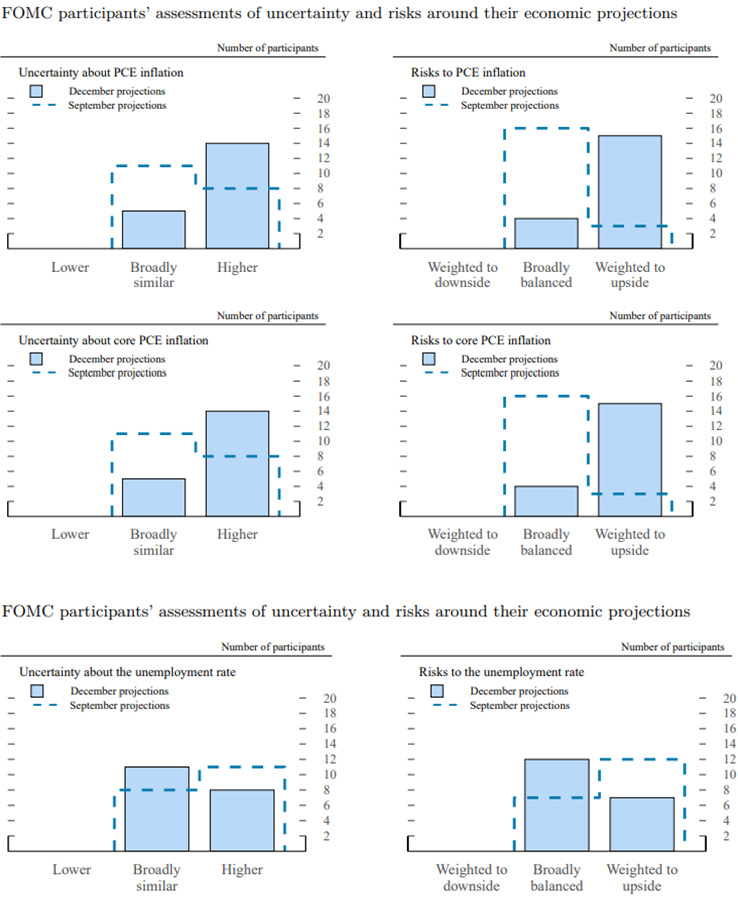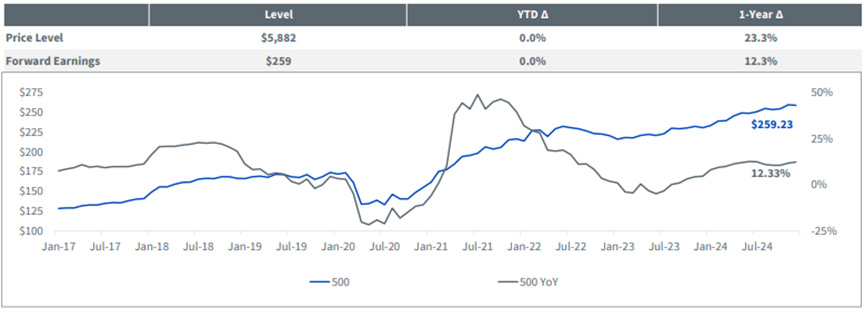By: Samuel Rines, Micro Strategist, Model Portfolios
Key Takeaways
- Despite widespread concerns about inflation and labor market resilience, the market’s focus on skewed risks presents opportunities for positive surprises if economic dynamics shift unexpectedly.
- Potential easing of tariffs and fiscal policy changes, such as tax cuts and deregulation, could boost corporate earnings, particularly for domestically focused industries like banking and energy.
- A weaker dollar, driven by improved inflation expectations, could enhance U.S. companies’ revenues and margins, positioning 2025 for better-than-expected outcomes in trade and corporate performance.
Welcome to the first blog post of the new year in our Navigating Earnings Season series. As we kick off 2025, the landscape is rich with competing narratives and evolving dynamics. From Federal Reserve policy shifts and persistent inflation concerns to the impact of tariffs and corporate earnings, the interplay between these forces will shape the investment landscape in unexpected ways. While skepticism around economic conditions is ever-present, these very uncertainties create opportunities for insightful analysis and surprising outcomes. In this series, I’ll explore how these themes play out through the earnings reports of major companies, offering a lens to navigate what promises to be a fascinating earnings season ahead.
Opportunities in a Shifting Market Landscape
There are no guarantees in markets. And—much of the time—that is where the opportunity arises. Whether it is around the FOMC or earnings dynamics or tariffs, markets tend to arrive at some kind of middle ground. At the moment, it seems nearly impossible to escape the chatter of a hawkish Federal Reserve, good earnings and bad tariffs. Oddly, it is concentrating on why these can be wrong that could lead to the most interesting investment outcomes. Consensus narratives are seductive. But they are also dangerous.
Probably the most interesting is the narrative around Federal Reserve policy. It was not all that long ago that markets were pricing in a significant rate-cutting cycle. That changed quickly as labor markets held up and inflation refused to decelerate enough for comfort. Now, markets are sometimes pricing in a single cut in 2025 or even none. The question to be answered is, “What could change that dynamic?” And that is simple. Either there could be a shift in the labor markets for the worse or inflation could surprise to the downside. Critically, the market is already pricing in a decent chance of inflation being sticky. Upside surprises to inflation prints will be much less painful than in the past. It is a skewed risk. As shown in figure 1, the Federal Reserve’s December 2024 Summary of Economic Projections highlights heightened uncertainty and significant upside risks to inflation compared to the labor market.
Figure 1: The Federal Reserve’s December 2024 Summary of Economic Projections

To be clear, that is not from “reading the tea leaves.” The FOMC clearly believes this to be the case. In their quarterly Summary of Economic Projections, participants saw higher uncertainty and greater upside risks to inflation. That was not the case when it came to the labor market. Inflation is the reason for a pause in easing. That makes sense: inflation has not cooperated. But then, the December CPI report was slightly lower on the margin, and markets reacted positively and dramatically.
The narrative is the opportunity.
And the potential for shifts in both trade and fiscal policies cannot be ignored either. There is a sense that tariffs will be problematic for inflation readings and corporate earnings. Counteracting the negativity is rhetoric around lower taxes and widespread deregulation of the economy. From banking to oil and gas, those are potential boons for bottom lines as the industries tend to be domestically focused and taxed. As shown in figure 2, the forward earnings per share (EPS) for the S&P 500 Index reveals a trajectory of steady growth since January 2016, reaching an expectation of more than 12% growth for 2025. This data reflects potential positive impacts from less-stringent tariff policies and other fiscal changes.
Figure 2: Forward EPS, S&P 500 Index, as of 12/31/24

And—again—it is those competing narratives that create a dynamic worth mentioning. The current expectation is for a touch more than 12% earnings growth for the S&P 500, with roughly $260 in earnings per share. Depending on one’s disposition, that may sound absurdly high, low or reasonable. But creating an opportunity for what could go right? Imagine a dynamic with tariff announcements being less onerous than expected. That would mean a weaker dollar (especially if inflation comes in lower than feared). U.S. companies sell a significant amount of their goods abroad, and a lower dollar means higher revenues, higher margins and better earnings. This would create a situation where changes in tax policy are further fuel for earnings growth, and those surprises translate to positive investment outcomes.
Simply, there are always reasons to be skeptical of the economy. That will never change. That is part of the reason there is the potential for things to go right. Looking at 2025, there are numerous possibilities for things to go better than expected. From FOMC policy to earnings to trade and fiscal policy, the risks on the margin may well be for a better-than-expected outcome.
Originally posted on January 23, 2025 on WisdomTree blog
PHOTO CREDIT: https://www.shutterstock.com/g/FGC
VIA SHUTTERSTOCK
DISCLOSURES
U.S. investors only: Click here to obtain a WisdomTree ETF prospectus which contains investment objectives, risks, charges, expenses, and other information; read and consider carefully before investing.
There are risks involved with investing, including possible loss of principal. Foreign investing involves currency, political and economic risk. Funds focusing on a single country, sector and/or funds that emphasize investments in smaller companies may experience greater price volatility. Investments in emerging markets, currency, fixed income and alternative investments include additional risks. Please see prospectus for discussion of risks.
Past performance is not indicative of future results. This material contains the opinions of the author, which are subject to change, and should not to be considered or interpreted as a recommendation to participate in any particular trading strategy, or deemed to be an offer or sale of any investment product and it should not be relied on as such. There is no guarantee that any strategies discussed will work under all market conditions. This material represents an assessment of the market environment at a specific time and is not intended to be a forecast of future events or a guarantee of future results. This material should not be relied upon as research or investment advice regarding any security in particular. The user of this information assumes the entire risk of any use made of the information provided herein. Neither WisdomTree nor its affiliates, nor Foreside Fund Services, LLC, or its affiliates provide tax or legal advice. Investors seeking tax or legal advice should consult their tax or legal advisor. Unless expressly stated otherwise the opinions, interpretations or findings expressed herein do not necessarily represent the views of WisdomTree or any of its affiliates.
The MSCI information may only be used for your internal use, may not be reproduced or re-disseminated in any form and may not be used as a basis for or component of any financial instruments or products or indexes. None of the MSCI information is intended to constitute investment advice or a recommendation to make (or refrain from making) any kind of investment decision and may not be relied on as such. Historical data and analysis should not be taken as an indication or guarantee of any future performance analysis, forecast or prediction. The MSCI information is provided on an “as is” basis and the user of this information assumes the entire risk of any use made of this information. MSCI, each of its affiliates and each entity involved in compiling, computing or creating any MSCI information (collectively, the “MSCI Parties”) expressly disclaims all warranties. With respect to this information, in no event shall any MSCI Party have any liability for any direct, indirect, special, incidental, punitive, consequential (including loss profits) or any other damages (www.msci.com)
WisdomTree Funds are distributed by Foreside Fund Services, LLC, in the U.S. only.
You cannot invest directly in an index.



